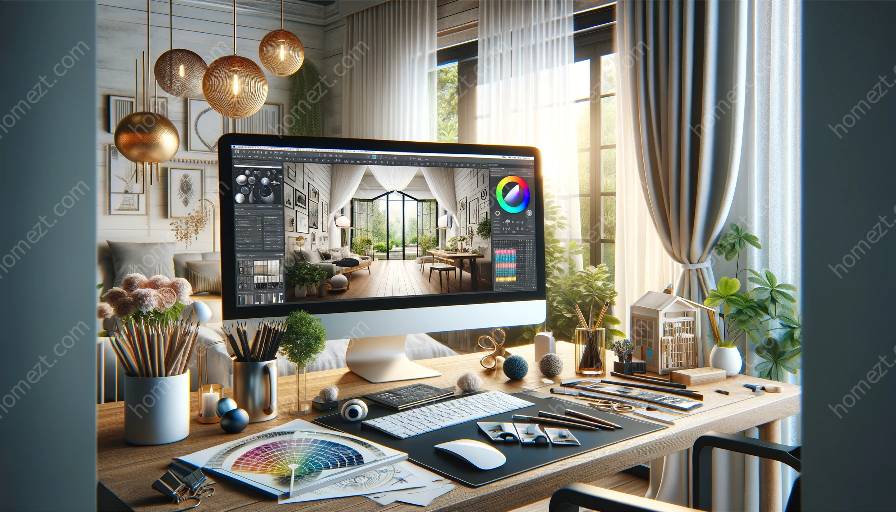In today's digital age, data analytics and visualization tools are revolutionizing the way interior design projects are conceptualized, planned, and executed. By harnessing the power of these tools, designers can create spaces that are not only visually stunning but also evidence-based, taking into account the nuanced needs and preferences of end-users. This article will explore how these tools can be seamlessly integrated into the interior design process, working in tandem with design software and contributing to a more informed and visually compelling design journey.
The Role of Evidence-Based Design in Interior Design
Evidence-based design (EBD) is a practice that involves designing spaces based on credible and verified research, with the goal of improving the functionality, aesthetics, and overall user experience of the space. By relying on empirical evidence and data, designers can craft environments that are not only pleasing to the eye but also support the physical, mental, and emotional well-being of the occupants.
To successfully incorporate evidence-based design principles into interior design projects, designers need access to reliable data and a means to effectively interpret and apply that data to the design process. This is where data analytics and visualization tools come into play, providing designers with the capability to gather, analyze, and present data in a way that informs and enriches their design decisions.
Integrating Data Analytics and Visualization Tools with Design Software
Many interior designers rely on sophisticated design software and tools to create 2D and 3D visual representations of their design concepts. These platforms offer capabilities for drafting floor plans, rendering virtual walkthroughs, and experimenting with various materials and finishes.
By integrating data analytics and visualization tools with design software, designers can elevate their design process to a whole new level. Through this integration, designers can access data-driven insights about user behavior, spatial flow, lighting preferences, and more, and seamlessly incorporate this information into their design models. This not only enhances the accuracy and relevancy of the design solutions but also enables designers to communicate their concepts more effectively to clients and stakeholders.
Advanced Data Analysis for Informed Design Decisions
Data analytics tools offer interior designers the ability to perform advanced analysis of various data sources relevant to a project. For instance, by leveraging demographic data, designers can gain a deeper understanding of the target users and their specific needs and preferences. This can inform decisions related to layout, color schemes, furniture selection, and spatial organization, leading to designs that are tailored to the unique demographic profile of the occupants.
Moreover, data analytics tools can provide insights into environmental factors such as temperature, humidity, and air quality, enabling designers to create environments that are not only aesthetically appealing but also conducive to health and well-being. The integration of environmental data into the design process aligns with the principles of evidence-based design, where the impact of the built environment on human health and performance is a key consideration.
Visualization Tools for Concept Communication and Validation
Visualization tools play a crucial role in helping designers communicate and validate their design concepts. Whether through photorealistic renderings, virtual reality simulations, or interactive 3D models, these tools enable designers to bring their designs to life in a visually captivating manner.
By incorporating data visualization techniques, such as heat mapping of user traffic, spatial analysis, or mood boards based on user survey data, designers can substantiate their design choices with empirical evidence. This not only strengthens the validity of the design decisions but also fosters a deeper understanding and appreciation of the design rationale among clients, users, and other stakeholders.
Driving Informed Design Conversations
One of the transformative aspects of integrating data analytics and visualization tools in the interior design process is the ability to facilitate informed design conversations. By presenting empirical data and visually compelling representations of design concepts, designers can engage in meaningful discussions with clients and stakeholders, guiding them through the decision-making process with a stronger foundation of evidence-based insights.
Through interactive presentations that showcase the impact of design choices on user experience, workflow efficiency, and environmental quality, designers can collaboratively fine-tune design solutions, leading to spaces that align more closely with the desired outcomes of all involved parties.
Enhancing the Iterative Design Process
The iterative nature of design necessitates continuous refinement and adjustment of design concepts based on feedback and evolving requirements. Data analytics and visualization tools provide designers with the means to iterate more effectively, as they can analyze user feedback, performance metrics, and user interaction data to identify areas for improvement and innovation in the design.
By leveraging real-time data and feedback loops, designers can refine their designs with greater precision, ensuring that each iteration is informed by user-driven insights and aligns with the overall objectives of evidence-based design. This iterative approach fosters a design process that is responsive, adaptive, and ultimately more attuned to the needs and aspirations of the end-users.
Conclusion
The integration of data analytics and visualization tools into interior design projects represents a seismic shift in the way designers approach evidence-based design. By harnessing the power of data and visualization, designers can create environments that are not only aesthetically pleasing but also grounded in empirical evidence, leading to spaces that support the well-being and satisfaction of their occupants.
As technology continues to evolve, the synergy between data analytics, visualization tools, and design software will further empower designers to craft spaces that are more responsive, personalized, and impactful. By embracing these tools and their potential to enrich evidence-based design, interior designers can embark on a journey of creativity and innovation that is deeply rooted in the principles of human-centered design.


























